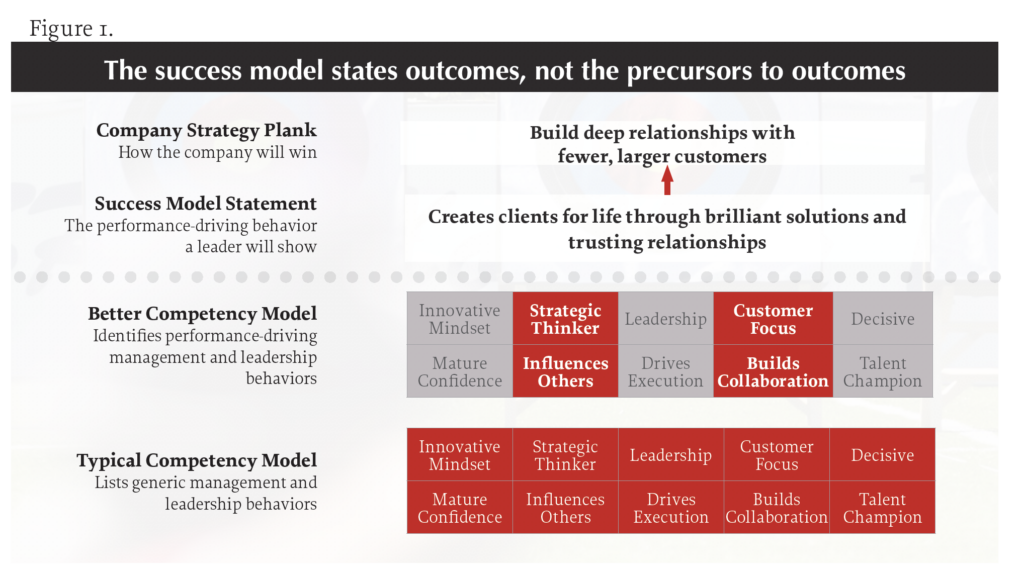The Success Model: What Your Executives Want you to Know

It’s the first morning of your new job. You’re excited because you’ve been selected to have coffee with the CEO to ask questions about the company.
She has a reputation as being straightforward and a bit impatient, so you’ve thoroughly prepared for this conversation. The barista hands you and the CEO your coffees and you walk together to a nearby table.
“Welcome to XYZ Co,” she says as she pulls in her chair. “What can I tell you about the company?”
“I’m so happy to be part of XYZ,” you respond, “and I want to understand how best to deliver results here. To that end, I’ve been studying the XYZ Leadership Model and I have a question about #14.”
As you say that, you hand her your phone with leadership competency #14 highlighted on the screen. She takes your phone from you, places it face down on the table and slowly leans back in her chair.
“I’m sure those are all fine,” she says dismissively. “HR does a good job with the models. But, if you want to win around here, you need to do these four things…”
Each of us would benefit from having that direct conversation about how to win at work. That CEO will describe the essence of success at your company. She will tell you the few differentiators that she and the executive team truly believe matter. Her “model” will contain no filler, no fluff and no nice-to-have’s.
Unfortunately, few of us will ever hear that version of leadership expectations. The CEO’s “four things” might be found somewhere in your leadership model, but likely without the emphasis, directness and simplicity with which she stated them. They’ll also be diluted with five, seven or even ten other “good citizen” behaviors that don’t differentiate.
More importantly, those four items are the CEO’s performance standard no matter what the formal leadership model says. She’ll evaluate, promote, reward and recognize people who demonstrate the behaviors she believes in.
When we don’t directly communicate the CEO and top team’s real leadership model, we create two sets of rules at work. There’s the published rules from HR that some leaders will dutifully follow, and the real set that the top team (and others) apply when it’s time to make important decisions about employees.
The Success Model
We call that CEO’s model a “Success Model” and it already implicitly exists in most organizations. We’re confident of this because when we interview executives about which people outcomes matter most in their company, they quickly and succinctly state them. They name three, four or maybe five elements. The language they use in that conversation rarely sounds like the sanitized and polished corporate communications statements that employees see.
What employees and leaders see instead is a behavior model that is simultaneously specific but generic, ambitious but uninspiring, academically perfect but practically flawed. It’s a long list of items or a short list with bullets and excessive verbiage. It is a perfect example of complexity not matched by value.
Employees and managers simply want to know what they need to do to thrive at their company. That’s what a Success Model does best.
Three things differentiate a Success Model from the typical leadership competency model:
- A Success Model includes only the “differentiating few”: The Success Model uses four to five statements to describe what will differentiate tomorrow’s stars. Each statement succinctly expresses one concept. It’s a holistic statement of the expected results, not a string of competencies tied together with conjunctions.
A focus on the differentiating few is beneficial for two reasons. First, it reinforces the reality that there is a hierarchy of organization priorities. A manager can engage in many important activities during her day. Yet a small number of those activities will have a disproportionately large impact on her, and the organization’s, success.
We owe it to busy managers to help them differentiate the critical from the merely important. (See sidebar: Are you Creating Good Citizens or High Performers?)
Second, identifying the differentiating few acknowledges the science that shows that people more accurately remember information when it’s presented in “chunks” of three or four. A manager will recall four success model statements far more easily than 10 leadership competencies. 1
This tight focus makes the Success Model easy to explain and simple to use to assess performance and potential.

- A Success Model focuses on outcomes: Managers want clarity about the outcomes for which they’re responsible. A Success Model describes the outcomes that define high performance, not the underlying behaviors that a competency model does.
For example, consider four leadership competency model staples: Strategic Thinker, Influences Others, Building Collaboration and Customer Focus. In the abstract, one could easily support the merits of each of these.
But a competency has no value on its own. It only has value when it’s applied to achieve a specific outcome. A leader could use those four competencies to deliver any number of different results. How is a leader expected to know exactly which outcomes her company desires?
As shown in Figure 1, a Success Model statement describes the outcome that the company values, e.g. “Creates clients for life through brilliant solutions and trusting relationships.” This statement is directly and tangibly linked to the company’s strategy, unlike a competency.
For leaders, that statement succinctly explains what they must deliver to “win” in their organization. It is purposefully agnostic about how those results are achieved, recognizing that there are many paths that might lead to the same result.

- A Success Model sounds like your company: Your executives may say that winning at their company means that leaders, “Grow teams that deliver legendary projects” or “Create clients for life through trusting relationships.” They don’t speak in competencies and you shouldn’t either.
Using natural phrasing makes the success model easier to understand and more emotionally engaging for leaders.
Creating a Success Model
A success model is developed using a process that’s similar to designing a leadership competency model. Your executives are interviewed and themes emerge.
The crucial difference is in how the interview is managed to identify the few differentiating behaviors and how the executives’ words and phrases are captured.

Implementing a Success Model
The power of a Success Model comes from making it the new “true north” in your organization. It should be integrated into every people process in the company.
Candidates should be interviewed using the Success Model as a framework. On-boarding should bring the model to life with live examples from leaders about how they apply it.
The model can be a screen for potential to advance. Your leadership education should focus on building those capabilities in as many leaders as possible, as quickly as possible.
Aligning a Success Model to a Competency Model
All your hard work building detailed leadership competencies doesn’t have to go to waste. While we don’t advocate sharing leadership competency models, this doesn’t mean that they aren’t a reasonable “back-pocket” tool.
Ideally a success model statement is written in a way that leaders at all levels can easily understand how to apply it to their role. There will still be some leaders who want to understand which leadership competencies are required by or built by each success model statement. For that reason, mapping from the success model to the leadership competencies associated with it can be a helpful exercise
A Better Way
HR’s goal should be to build as many high performing leaders as we can, as quickly as we can. Competency models helped to advance us beyond using subjective and biased standards to select and grow leaders.
We must now help our leaders to understand the vital few results that differentiate the best. They aren’t concerned with how artfully or elegantly we present the model. They simply want to know what’s required to win.
References
- Cowan, N., Morey, C.C., & Chen, Z.. The legend of the magical number seven. In S. Della Sala (Ed.), Tall tales about the brain: Things we think we know about the mind, but ain’t so. Oxford University Press, 2007.